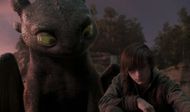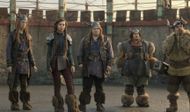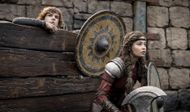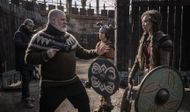The live-action version of How to Train Your Dragon came out on June 13, 2025, and it brought more than just a visual upgrade. The story still follows Hiccup, an awkward Viking teenager trying to fit in. He meets Toothless, who is supposed to be the most dangerous dragon in the world. Instead of killing him, Hiccup decides to help him—and this choice changes everything in his village.
The basics of the How to Train Your Dragon live-action are the same as the 2010 animated film, but this new version makes a lot of deeper changes. Characters like Astrid and Snotlout are given more backstory and better reasons for how they act. Some moments feel heavier because the emotions are more real and the danger feels closer. The action scenes are longer, and the dragons look more frightening.
In the live-action version, the tone is more serious and the jokes are less frequent. Even the emotional moments hit differently because the actors bring more weight to them. This remake doesn’t feel like a copy of the original—it feels like a new take that tries to be more grounded. Here are seven of the biggest changes that stand out in the live-action remake of How to Train Your Dragon.
They changed these 7 things in the live-action movie of How to Train Your Dragon
1. Astrid’s anger toward Hiccup is rooted in privilege

In the live-action version of How to Train Your Dragon, Astrid doesn’t just ignore Hiccup like she did in the animated one. She voices exactly why she’s frustrated, and it has everything to do with how Hiccup benefits from being the chief’s son. She calls him out for getting chances others don’t and tells him he hasn’t earned the respect he receives.
Astrid also says she wants to be chief one day and believes Hiccup is standing in her way. She is direct and honest, and this creates real conflict between them. It builds tension in a way the animated film never explored.
When she chooses to support him later, it carries more meaning because now the audience knows what she had to work through. This change gives Astrid her own clear goals and adds weight to every scene she shares with Hiccup. It helps their dynamic feel earned, not rushed.
2. Snoutlout has a full arc with his Father

The animated film, How to Train Your Dragon, never gave Snotlout much beyond his bully routine. He teased Hiccup and acted like he had something to prove, but there was no explanation. The live-action version changes that by focusing on his father, Spitelout.
Snotlout keeps trying to get his father’s attention but gets ignored every time. Spitelout is cold and dismissive and never offers praise or interest. This adds pressure and explains why Snotlout behaves the way he does. He’s not just rude—he’s desperate to be noticed.
In the final battle, Snotlout shows courage, and Spitelout finally gives a sign of approval. That moment becomes more than just a victory—it becomes closure. The change makes Snotlout more human and less like a stock character. It also mirrors Hiccup’s own struggles with Stoick. Both boys want the same thing; they just take different paths to get there. Now, both get resolution.
3. The Vikings of Berk are more diverse

The animated Berk looked simple and uniform. Everyone had similar features, and the world felt small. The live-action version changes that by introducing people from different backgrounds. This change isn’t just visual—it’s explained in the story.
Stoick says Berk was built by dragon hunters from every land they reached. This means Berk is made up of families from across different parts of the world. It adds a layer of realism and helps the audience see the village as a real community.
The diversity doesn’t change the plot, but it does expand the world. It shows that dragon problems aren’t limited to one group. It also makes the story feel more current. The message of unity and understanding works better when the village itself reflects it. This version of Berk feels larger and more believable, which makes the entire How to Train Your Dragon setting more engaging.
4. Gobber’s missing leg was Switched

In the animated film, Gobber is missing his right leg and his left arm. That design worked for the original actor, but things changed for the live-action remake of How to Train Your Dragon. Actor Nick Frost had knee issues on one side, so the filmmakers adjusted Gobber’s leg accordingly.
The new version of Gobber is missing his left leg instead. It’s a small change, but it shows the production made space for real-life challenges. Frost needed to move and act without strain, so the character’s build was updated to support that.
This tweak doesn’t change who Gobber is. He’s still loud and loyal and full of dry humor. The choice makes the character feel grounded because it reflects a real condition. It’s not about accuracy to the original—it’s about making the actor comfortable while still delivering a performance that fits the tone of the remake. It works without calling attention to itself.
5. Fishlegs tries to save Hiccup

Fishlegs always had the role of the dragon-obsessed student. In the animated version, he mostly explained dragon facts and stayed out of serious action. The live-action version adds one specific scene that changes how people view him.
When Hiccup is about to be attacked in the training arena, Fishlegs doesn’t just freeze. He reaches through the barrier and tries to pull Hiccup to safety. The attempt fails, but the moment matters—it shows that Fishlegs cares enough to take a risk.
This makes Fishlegs more than just a funny side character. He becomes someone who sees Hiccup as more than the chief’s son. He acts like a friend before anyone else does. That kind of gesture strengthens the story of how Hiccup begins to gain support. The moment is quiet, but important. It helps build a believable shift in how the village starts to change its thinking—one of the many subtle but meaningful additions in the live-action How to Train Your Dragon.
6. An emotional scene with Stoick and Astrid was added

The scene where Stoick finds Toothless lying still is almost the same in both versions. He believes Hiccup has died and drops to his knees. In the live-action film, something small is added that changes the entire mood of the moment.
Astrid approaches him and places her hand on his shoulder. She doesn’t speak. She just stands with him. This single gesture shows that Stoick is no longer alone in his grief. The younger generation is not only watching—they are now stepping in.
The addition gives Astrid more weight in the story. She is no longer just a partner to Hiccup—she is a bridge between the old and the new. Her quiet support deepens the loss Stoick feels and makes the relief hit harder when Hiccup wakes up. The scene now shows how far everyone has come together. It becomes about more than just one father and one son and adds emotional depth to the live-action How to Train Your Dragon.
7. The tone is darker and more serious

The animated film, How to Train Your Dragon, had a light tone, even in serious moments. The characters joked often, and the animation softened the danger. The live-action version removes those layers and focuses on real consequences. The tone is heavier from the start.
The dragons look scarier. The fights last longer. The arguments between Hiccup and Stoick feel personal. There’s no safety net in this version. When someone gets hurt, it feels like it matters. When someone speaks, it cuts deeper.
This change makes Hiccup’s decision to protect Toothless feel bold, not quirky. It adds tension to every scene and makes the final battle feel like a real fight for survival. Even small lines of dialogue carry more weight. The tone shift helps the remake stand on its own. It doesn’t feel like a copy—it feels like the same story told with higher stakes and a clearer sense of risk and reward.
Follow for more updates.
Love movies? Try our Box Office Game and Movie Grid Game to test your film knowledge and have some fun!
